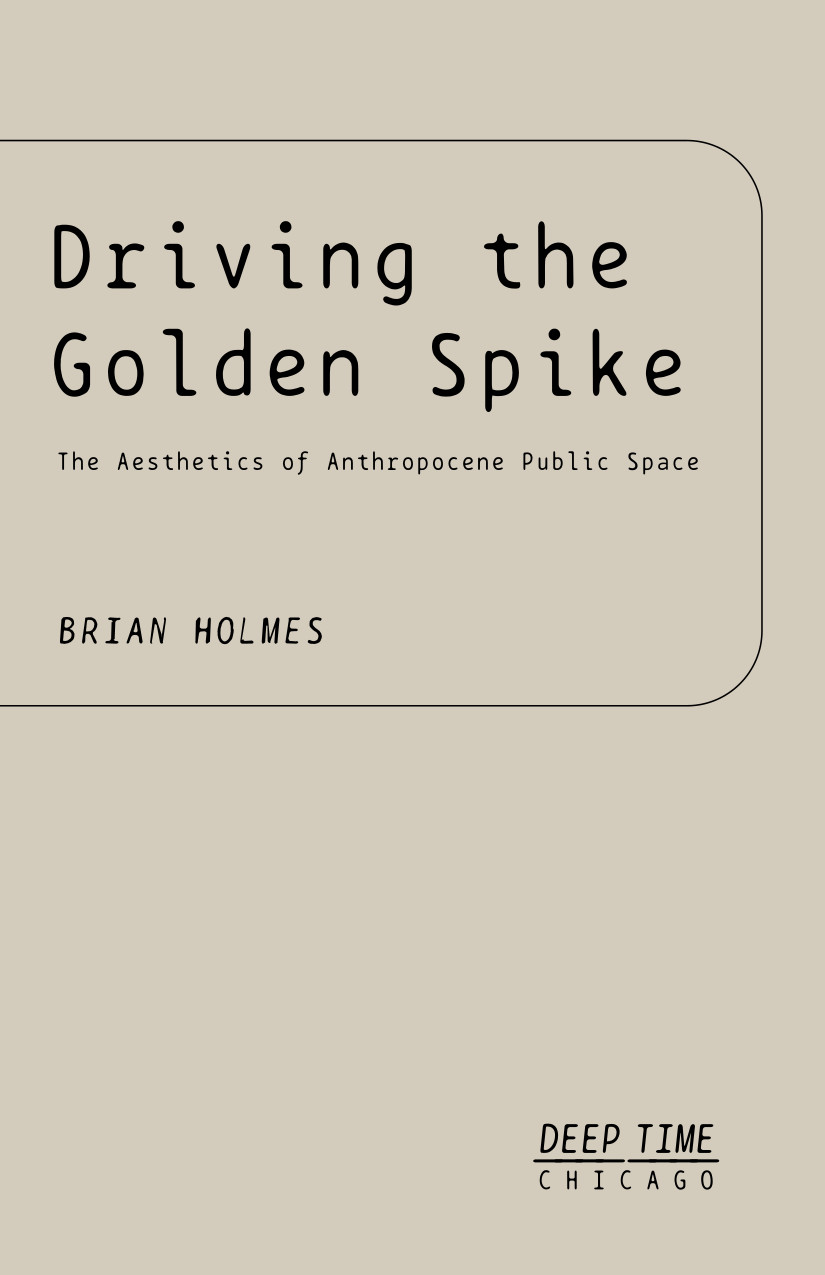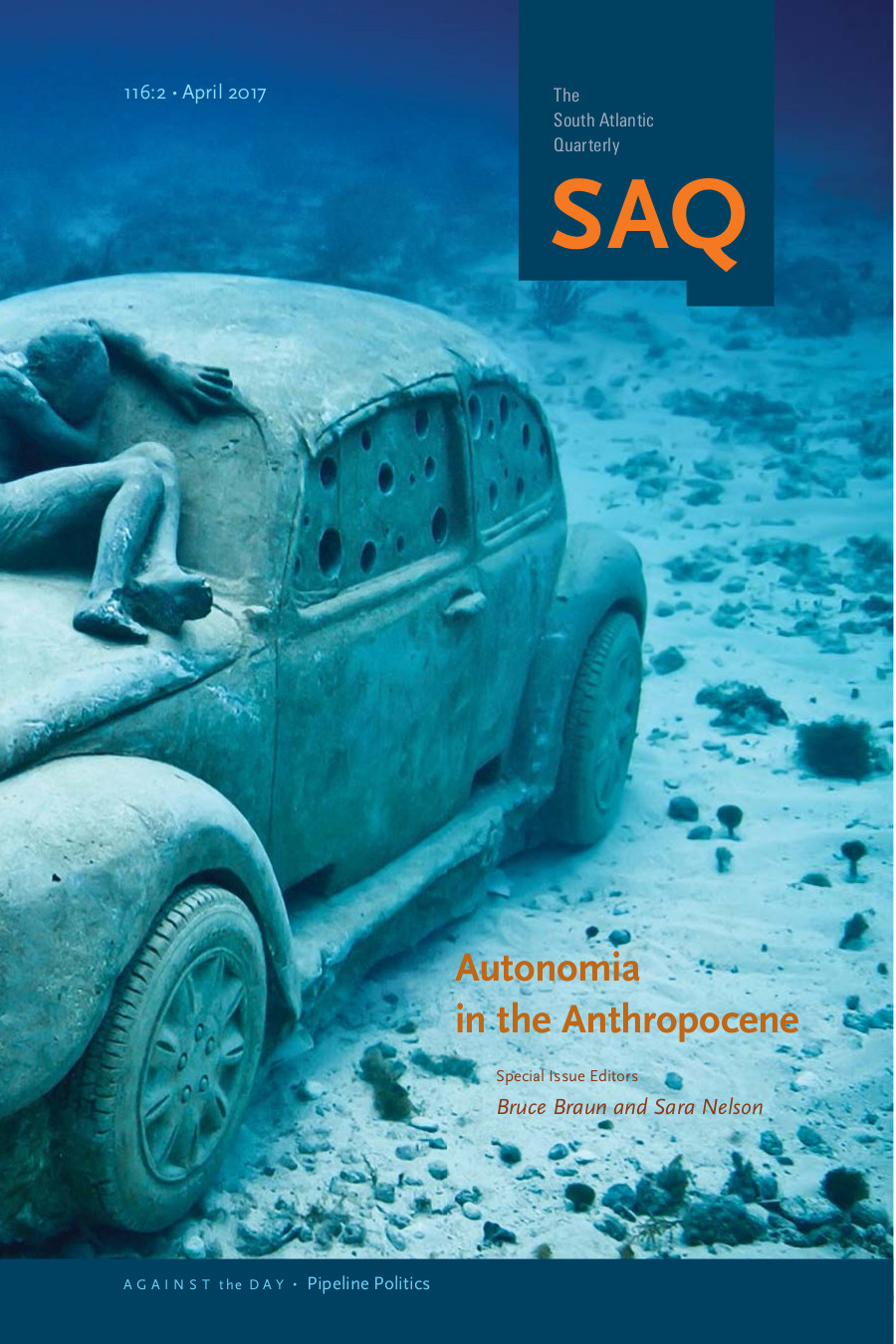Brian Holmes: Driving the Golden Spike: The Aesthetics of Anthropocene Public Space (2016)
Filed under pamphlet | Tags: · aesthetics, anthropocene, public space, theory

“The idea came to me, ironically, while driving around Chicago. It was high summer; I was on the city’s shattered West Side. The urban grid slid by outside the window, residential vernacular on its third or fourth recycle, parched and decayed, with a kind of lost and disjointed vibrancy. Eyes on the traffic, my mind rolled back over the city’s history: its canals and granaries and skyscrapers, its formidable industrial century since the arrival of the railroads in the 1850s, its suburban sprawl after the Great Fire of 1873, its postmodern decline made irreversible by the 1960s revolts and the capital flight that followed. Through it all, the university and financial sectors continued their endless rise. There is a profound violence to this place, but also a deep sense of regularity. Chicago is the race-riot city that turns civil strife into social norms, and splits atoms while abstracting material production into mathematical derivatives. Can you still experiment in a place that has successively been the transport hub, the stockyard, the workshop, the vitrine, the boxing-ring, and quite literally the laboratory of modernism? And what could this ideal of experimentation mean for our future, when its Promethean pasts have reappeared before our eyes as the new geological layer of the Anthropocene?” (opening paragraph)
Publisher Deep Time Chicago, September 2016
Creative Commons BY-ND 4.0 International License
19 pages
Video lecture (April 2016, 47 min)
Publisher
PDF, PDF
HTML (e-flux, Oct 2017)
South Atlantic Quarterly, 116(2): Autonomia in the Anthropocene (2017)
Filed under journal | Tags: · anthropocene, autonomy, capitalism, cognitive capitalism, commons, labour, marxism, multitude, subjectivity

“Despite Autonomia’s widespread influence on political action and post-Marxist scholarship, it has been surprisingly slow to address planetary change and environmental politics. With a focus on cognitive capitalism, many autonomist scholars have downplayed or fully ignored the ecological dimensions of post-Fordism—its foundations in extractive energy economies, its links to the accelerating financialization of nature under the banner of so-called green capitalism, its harnessing of nonhuman capacities, and its wildly uneven toxic geographies. This lack of engagement is regrettable given that, we propose, autonomist insights hold great promise for understanding both the transformed relation between capital and nonhuman natures in post-Fordism and the many political movements that have emerged in response. […]
It is no longer evident that key terms found in the autonomist lexicon—species being, the common, multitude, potentia—survive the challenge of the Anthropocene unchanged or that the production of subjectivity (a cornerstone of autonomist thought) can be understood solely in terms of language, habit, or gesture. It may therefore be necessary to think beyond the struggles of the factory floor, or those of the cognitariat today, to imagine and think from other sites of struggle, other forms of solidarity, and other experiments in “commoning.” These bring into play unfamiliar actors and unacknowledged geographies: sites of extraction and circuits of waste, indigenous communities and territories, rising seas and toxic landscapes that are materially present within the informationalized economies of global capitalism, but often invisible to those working within them. We might say, then, that the Anthropocene names autonomist Marxism’s unthought, an unthought that intrudes on its political imaginaries. What happens to autonomism if it begins to question the autonomy of the human? Or if it leaves its privileged sites in the global North?”
With contributions by Sara Nelson and Bruce Braun, Miriam Tola, Jason Read, Elizabeth R. Johnson, Elizabeth A. Povinelli, Matteo Pasquinelli, Karen Pinkus, Marco Armiero and Massimo De Angelis, Anja Kanngieser and Nicholas Beuret, and Isabelle Stengers.
Edited by Sara Nelson and Bruce Braun
Publisher Duke University Press, Apr 2017
ISSN 0038-2876
178 pages
Bernard Stiegler: The Neganthropocene (2018)
Filed under book | Tags: · anthropocene, capitalism, cinema, technics, technology, theory

“As we drift past tipping points that put future biota at risk, while a post-truth regime institutes the denial of ‘climate change’ (as fake news), and as Silicon Valley assistants snatch decision and memory, and as gene-editing and a financially-engineered bifurcation advances over the rising hum of extinction events and the innumerable toxins and conceptual opiates that Anthropocene Talk fascinated itself with—in short, as ‘the Anthropocene’ discloses itself as a dead-end trap—Bernard Stiegler here produces the first counter-strike and moves beyond the entropic vortex and the mnemonically stripped Last Man socius feeding the vortex.
In the essays and lectures here titled Neganthropocene, Stiegler opens an entirely new front moving beyond the dead-end “banality” of the Anthropocene. Stiegler stakes out a battleplan to proceed beyond, indeed shrugging off, the fulfillment of nihilism that the era of climate chaos ushers in. Understood as the reinscription of philosophical, economic, anthropological and political concepts within a renewed thought of entropy and negentropy, Stiegler’s ‘Neganthropocene’ pursues encounters with Alfred North Whitehead, Jacques Derrida, Gilbert Simondon, Peter Sloterdijk, Karl Marx, Benjamin Bratton, and others in its address of a wide array of contemporary technics: cinema, automation, neurotechnology, platform capitalism, digital governance and terrorism. This is a work that will need be digested by all critical laborers who have invoked the Anthropocene in bemused, snarky, or pedagogic terms, only to find themselves having gone for the click-bait of the term itself—since even those who do not risk definition in and by the greater entropy.”
Edited, translated, and with an introduction by Daniel Ross
Publisher Open Humanities Press, London, 2018
CCC2: Irreversibility series
Creative Commons BY-SA 4.0 License
ISBN 9781785420481
345 pages

